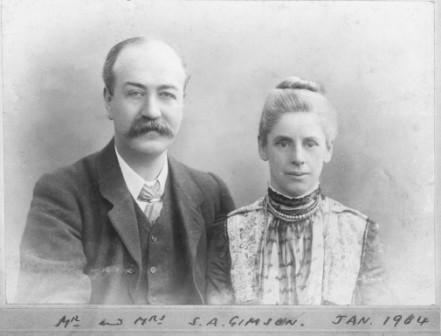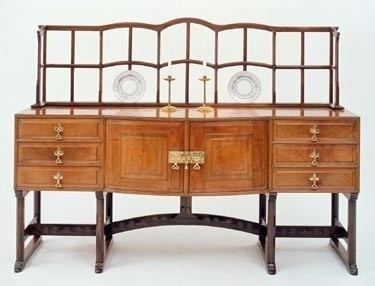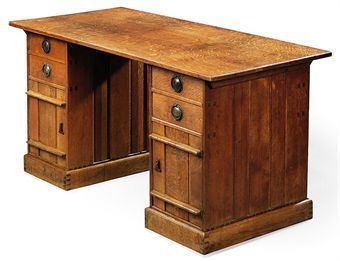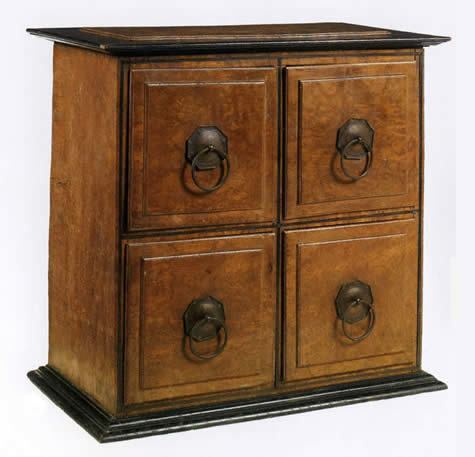Occupation Architect Name Ernest Gimson | Role Designer | |
 | ||
Died August 12, 1919, Sapperton, United Kingdom | ||
Paul Spriggs | Furniture Maker at The Gloucestershire Guild Of Craftsmen
Ernest William Gimson (; 21 December 1864 – 12 August 1919) was an English furniture designer and architect. Gimson was described by the art critic Nikolaus Pevsner as "the greatest of the English architect-designers". Today his reputation is securely established as one of the most influential designers of the English Arts and Crafts movement in the late nineteenth and early twentieth centuries.
Contents
- Paul Spriggs Furniture Maker at The Gloucestershire Guild Of Craftsmen
- Early career
- Sapperton Gloucestershire
- Architectural work
- Legacy
- References

Early career

Ernest Gimson was born in Leicester, in the East Midlands of England, in 1864, the son of Josiah Gimson, engineer and iron founder, founder of Gimson and Company, owner of the Vulcan Works. Ernest was articled to the Leicester architect, Isaac Barradale, and worked at his offices on Grey Friars between 1881 and 1885. Aged 19, he attended a lecture on 'Art and Socialism' at the Leicester Secular Society given by the leader of the Arts and Crafts revival in Victorian England, William Morris, and, greatly inspired, talked with him until two in the morning, after the lecture.

Two years later, aged 21, Gimson had both architectural experience and a first class result from classes at Leicester School of Art. He moved to London to gain wider experience, and William Morris wrote him letters of recommendation. The first architectural practice he approached was John Dando Sedding, where he was taken on, and stayed for two years. From Sedding, Gimson derived his interest in craft techniques, the stress on textures and surfaces, naturalistic detail of flowers, leaves and animals, always drawn from life, the close involvement of the architect in the simple processes of building and in the supervision of a team of craftsmen employed direct. Seddings offices were next door to the showrooms of Morris & Co., providing opportunity to see first hand the first flourishing of Arts and Crafts design. He met Ernest Barnsley at Sedding’s studio, and through him, Sidney Barnsley, a friendship that was to last the rest of his life.

After a brief period traveling in both Britain and Europe, Gimson settled in London again and in 1889 he joined Morris’s Society for the Protection of Ancient Buildings (SPAB). In 1890, he was a founder member of the short-lived furniture company, Kenton and Co., with Sidney Barnsley, Alfred Hoare Powell, W.R. Lethaby, Mervyn Macartney, Col. Mallet and Reginald Blomfield. Here they acted as designers rather than craftsmen and explored inventive ways of articulating traditional crafts, "the common facts of traditional building", as Philip Webb, "their particular prophet", had taught. Gimson had also, through the Art Workers' Guild, become interested in a more hands on approach to traditional crafts, and in 1890 spent time with Philip Clissett in Bosbury, Herefordshire, learning to make rush-seated ladderback chairs. He also began experimenting with plaster work.
Sapperton, Gloucestershire

Gimson and the Barnsley brothers moved to the rural region of the Cotswolds in Gloucestershire in 1893 "to live near to nature". They soon settled at Pinbury Park, near Sapperton, on the Cirencester estate, under the patronage of the Bathurst family. In 1900, he set up a small furniture workshop in Cirencester, moving to larger workshops at Daneway House, a small medieval manor house at Sapperton, where he stayed until his death in 1919. He strove to invigorate the village community and, encouraged by his success, planned to found a Utopian craft village. He concentrated on designing furniture, made by craftsmen, under his chief cabinet-maker, Peter van der Waals, whom he engaged in 1901.
Architectural work
His architectural commissions include
Legacy
The Sapperton workshop was closed after Gimson's death, but many of the craftsmen went with Peter van der Waals to his new premises in Chalford.
His architectural style is "solid and lasting as the pyramids… yet gracious and homelike" (H. Wilson, 1899). Lethaby described him as an idealist individualist: "Work not words, things not designs, life not rewards were his aims." Norman Jewson was his foremost student, who carried his design principles into the next generation and described his studio practices in his classic memoir By Chance I did Rove (1951).
Today his furniture and craft work is regarded as a supreme achievement of its period and is well represented in the principal collections of the decorative arts in Britain and the United States of America. Specialist collections of his work may be seen in England at the New Walk Museum, Leicester, and in Gloucestershire at the Cheltenham Art Gallery and Museum, Rodmarton Manor and Owlpen Manor.
